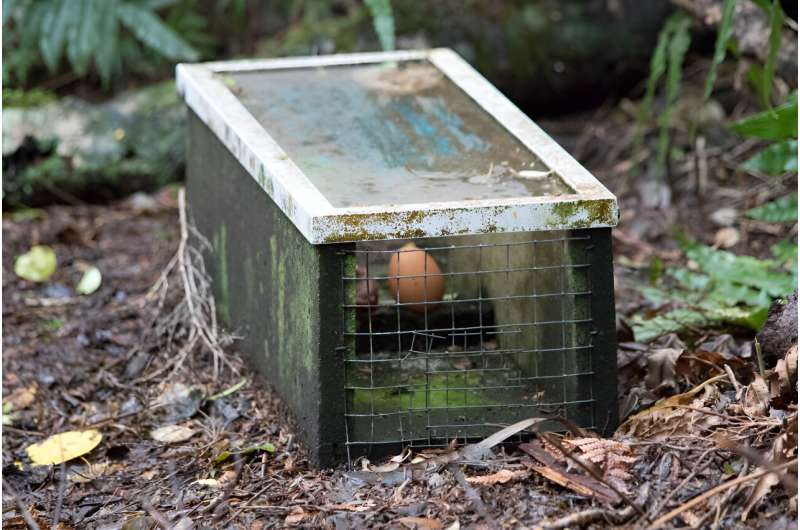This article has been reviewed according to Science X's editorial process and policies. Editors have highlighted the following attributes while ensuring the content's credibility:
fact-checked
peer-reviewed publication
proofread
How better understanding of stoat behavior will help predator control in Aotearoa

It's well-known that Aotearoa New Zealand's native ecosystems are under threat from introduced pest predators such as rats, cats, possums and stoats.
Trapping efforts, such as those undertaken by Predator Free NZ groups, are effective up to a point—but it is very difficult to achieve 100% eradication of these predators, especially across large, remote areas.
One of the aims of the five-year MBIE Endeavour science program Eradication Science, coordinated by Manaaki Whenua—Landcare Research, is to evaluate the current toolkit of trapping technologies from the perspective of the pest. New knowledge is needed on why some pest animals evade or fail to interact with physical traps, and to devise ways to make the traps more enticing.
As part of the research, Drs Patrick Garvey and Kyla Johnstone, working with Dr. Catherine Price at the University of Sydney, tested the responses of wild-caught stoats to three existing types of stoat trap. The findings are published in the Journal of Applied Ecology.
The traps were disabled so that they could be triggered without harming the animals. This enabled the intrinsic behaviors of the stoats to be assessed across different trap encounters.
The experiment was run over 81 nights with 28 stoats—13 male and 15 female—and the stoats' behavior was filmed each night using infrared cameras. The research complied with all relevant animal welfare and ethics requirements.
In a classic rewriting of the phrase "fortune favors the brave," the researchers found that fortune favors the shyer, more cautious, less active, and less risk-prone stoats—known as "recalcitrant" animals in pest-control circles—that are less likely to interact with all types of traps. Shy female stoats, and female stoats generally, were more cautious and less likely to interact with the traps than male stoats.
This finding is known from field trapping, where successful capture is strongly skewed towards males.
Often, all it takes for an area to be repopulated is the survival of females that evade trapping. Almost all adult female stoats are pregnant throughout the year, so understanding sex biases in trap capture is essential to achieve eradication.
By contrast, "neophile" stoats—those attracted to risk and novelty—were more likely to approach and then trigger a trap. Enclosed box traps were the most effective type of trap all round, but neophile stoats were also attracted to tunnel traps. Stoats tended to interact least with head-up traps.
Is the answer to deploy more traps, to ensure that the more cautious individuals will be more likely to encounter devices? Not necessarily, say the researchers, since stoats that encountered a trap for the first time and failed to trigger it were quite likely to avoid all traps in the future—trap shyness is a persistent problem for predator control.
Although the box trap performed well, capturing three in four stoats during their first encounter, no single design covered all spectrums of personality, suggesting that less "scary" trap designs, plus more effective baits and lures, are what's needed.
Compounding the problem of trap shyness, the researchers suspect that they have actually underestimated recalcitrance in the wild.
By definition, all the stoats in the study had the characteristics of risk-taking neophiles, since they had already been caught in a trap for the study. This suggests that trapping the most recalcitrant animals might be even more difficult than this study suggests, which itself is an important finding in planning future pest control efforts.
Applying these behavioral nuances in the field will be challenging but not impossible. The researchers conclude that increasing the likelihood of engagement with a trap during a first encounter, and improving the susceptibility of the animal to triggering that trap, is fundamental to increasing capture success in future predator management programs.
Next steps for the Eradication Science program involve the development and deployment of novel lures to do just that.
More information: Kyla C. Johnstone et al, Personality, sex and capture biases: Challenges for predator monitoring and management, Journal of Applied Ecology (2024). DOI: 10.1111/1365-2664.14724
Journal information: Journal of Applied Ecology
Provided by Manaaki Whenua - Landcare Research





















